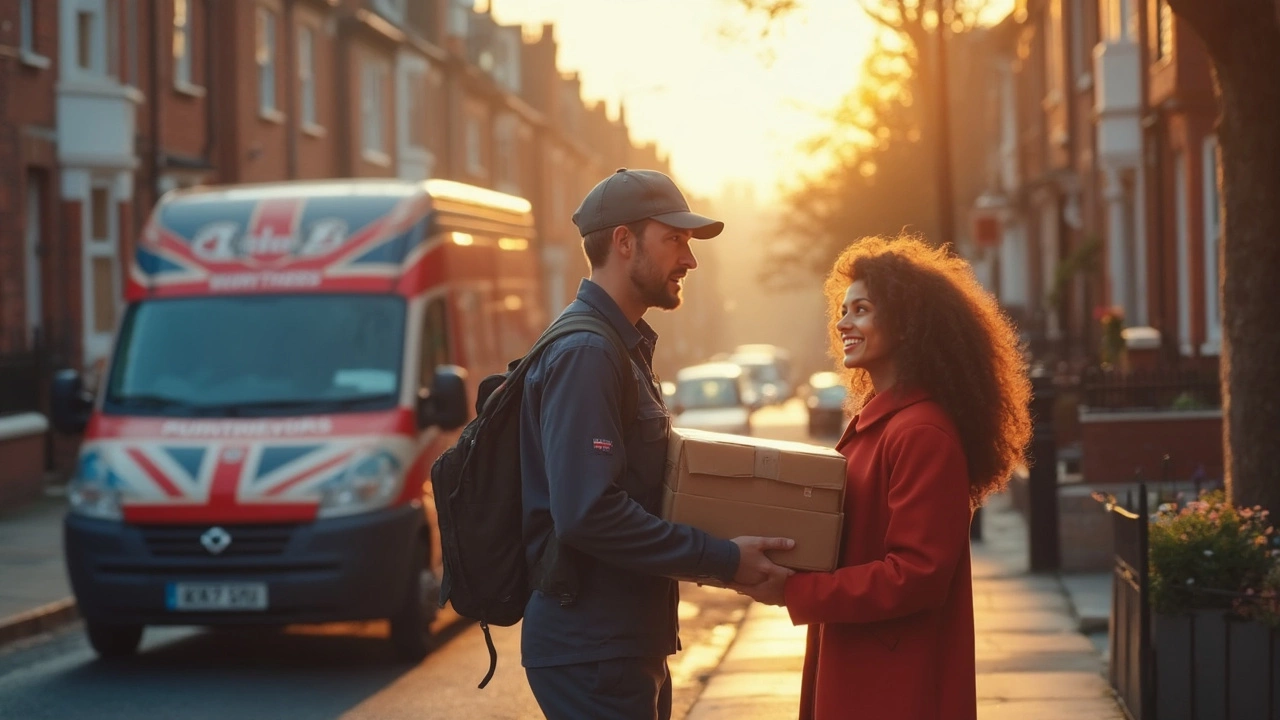Next Day Delivery Explained: How It Works and What You Should Know

If you've ever ordered something online at midnight and had it on your doorstep almost magically the next day, you've experienced that little hit of modern shopping adrenaline—next day delivery. It's one of those things you can't really appreciate until you've relied on it. Ever needed a forgotten birthday gift in a panic? Or run out of printer ink right before a work deadline? It's next day delivery to the rescue, and it almost feels like cheating the system.
What Is Next Day Delivery?
Next day delivery means your package gets whisked away from a warehouse and lands at your door the very day after you place your order. It's not the same as express or two-day shipping—this is about getting what you need in 24 hours flat. The way it works is simple in theory: once you hit the “Buy Now” button, the clock starts ticking. Companies like Amazon, Walmart, and Target have made this almost standard, but it's not just for giant retailers. Lots of smaller businesses juggle logistics to offer next day delivery too.
This speedy shipping method relies on networks of warehouses, smart inventory management, and tight partnerships with major couriers. Orders get picked, packed, and shipped out of nearby hubs—sometimes local stores double as warehouses—right up until a shipping cutoff time (sometimes as late as 11 p.m.). Major players use advanced software, mapping algorithms, and sometimes even robots or automated sorting machines to move products at breakneck speed. Those little delivery vans zipping around your city late at night? They’re part of a finely tuned system working overtime to keep promises.
But don’t let the magic fool you—next day delivery is a logistical thriller behind the scenes. Packages have to be ready for courier pickup almost as soon as the order is placed, so there's zero room for error. If you live farther from metro areas or order after the cutoff time, the magic might miss you by a day. Cold truth: next day isn’t always available for every product, especially if it’s a large appliance or something quirky stashed in a warehouse across the country. Still, next day shipping has become so common that many of us schedule our lives around it without realizing.
How Does Next Day Delivery Really Work?
This is where things get a little more interesting (or, if you’re a logistics buff like me, downright fascinating). Let me break it down. First, your favorite store decides what products are popular enough to keep stocked in warehouses close to where you live. This sounds simple, but they use sales data, predictions, and even weather forecasts to make those decisions. Next, they set up a network of couriers—FedEx, UPS, USPS, and sometimes local drivers or gig workers—to be on standby for morning pickups.
When your order lands in the system, everything moves fast. Automated robots zoom around the warehouse, picking your items and dropping them onto conveyor belts. Packagers hustle to box your stuff, slap on a label, and hand it off to the shipping team. By late afternoon or evening, a driver scoops up scores of parcels and races to sorting centers. Some major companies run their own fleet of trucks and even airplanes; Amazon, for instance, has its own cargo jets in the U.S. that zip packages across states overnight. That’s why folks in cities and suburbs usually get next day delivery faster and with fewer hiccups than those in rural spots.
The next part is like a relay: your package leaves the hub, travels to a central sorting facility, gets rerouted to a city depot, and finally is dispatched to your local area for last-mile delivery. Sometimes, the last leg—the so-called “final mile”—is handled by Amazon Flex drivers or DoorDash couriers using their own cars. Drivers work late into the night (and I mean sometimes up to midnight, especially around the holidays) to make sure the next day delivery promise is kept. It’s this last-mile scramble that costs companies the most and is where most shipping headaches happen.
Missed cutoff times, bad weather, and human error can all throw a wrench in the works. That’s why, if you order on a Friday night, you might not get next day delivery until Monday—weekends can be tricky, and not all couriers run seven days a week. Still, most urban and suburban areas now see next day packages delivered even on Saturdays thanks to expanded courier service. Keep an eye out for those little cutoff clocks on checkout pages—if you miss the deadline, your package gets bumped to two-day delivery instead. Kind of a bummer, but also understandable when you see how tightly optimized the whole thing is.

Interesting Facts and Insider Tips
Time for some real talk about how to work the next day delivery system to your advantage—and a few things that might surprise you. Did you know that companies sometimes upgrade your shipping to next day for free if your order is late? They're not legally required, but it keeps customers happy, so it happens more often than you think. Also, small business sellers on platforms like Etsy or Shopify can offer next day delivery if they team up with same-day couriers or have products already stocked at fulfillment centers close to you.
But here’s the catch: not every product—even on Amazon Prime—can race to you by the next day. Look closely for labels like “Prime One-Day” or “Available for Next Day Delivery.” If the promise isn’t spelled out in bold, check your delivery estimate during checkout. Another tip: if you’re in a rush and need something on a weekend, look for retailers offering in-store pickup or local same-day partners. Sometimes, local delivery apps team up with stores to offer next day or even same-day shipping for a little extra.
There’s also a bit of an environmental pushback happening. All those extra delivery vans increase traffic, burn more fuel, and pump out more emissions, especially when they’re racing against deadlines. Some green-minded companies now give you discounts or loyalty points for bundling shipments or choosing slower delivery speeds. If you’re not in a rush, this is a real way to be kind to the planet while saving a few bucks.
Here are a few actionable tips for using next day delivery like a pro:
- Order early in the day to guarantee you beat the shipping cutoff.
- Double check the delivery window during checkout and don’t trust the home page claims.
- If it’s urgent, select local stores with pickup or local shipping partners.
- For recurring needs (pet food, diapers, toner), set up automated next day subscriptions. Saves time and cuts the "oops, we’re out" stress.
- If you live just outside a metro area, consider shipping to a friend in the city and picking it up yourself (some people do this for hard-to-find items or gifts!).
And don’t fall for common myths: next day delivery isn’t always expensive—many times it’s free for loyalty program members or big spenders. But beware of store policies. If you need to return a next day order, sometimes the return ship label isn’t next day, so factor a little extra time if you’re on a deadline for exchanges or refunds.
How Next Day Delivery Is Changing Shopping
Let’s talk about the real impact. Next day delivery has completely changed how we shop, plan, and live. Retail giants used to battle over price and choice; now, speed is the ultimate battleground. Amazon set the pace, but even grocery chains, pharmacies, and hardware stores now chase the “order today, get it tomorrow” model. For some products—medicine, baby supplies, anything needed in a pinch—next day isn’t just a perk, it’s nearly essential.
This race for speed has also led to a whole new class of startups. Some are all about “last mile” logistics, offering ultra-fast delivery as a paid upgrade or creating networks of local drivers who operate more like ride-share apps for stuff instead of people. Big companies have even started buying up delivery startups just to stay ahead. Tech like smart route planning, AI, and real-time tracking has ramped up in the last couple years to make the whole process almost seamless.
On the customer side, expectations are higher than ever. In a 2024 survey, more than 70% of online shoppers said they’d abandon a cart if next day wasn’t an option on at least half the items. That’s how “normal” it’s become. Even business buyers—think office managers or small repair shops—now order inventory last minute, knowing it’ll be there the next day with a tap of a button.
But there’s a flip side: the “instant everything” mindset isn’t always sustainable. Smaller businesses struggle to keep up with the costs of constant fast shipping, and that last-mile delivery is hard on drivers. Some companies are experimenting with ways to balance speed and cost, like using pickup lockers, parcel shops, or crowdsourced delivery drivers. Others are limiting next day to specific high-demand products or locations. It’s a delicate balance—give people speed, but don’t lose your shirt paying for it.
Looking ahead, we might see drones or autonomous vehicles delivering some next day orders, especially in big cities where traffic is brutal. Companies are also experimenting with reusable packaging and greener delivery vans to address the environmental challenges. What started as a convenience is now shaping the future of retail, logistics, and even the way neighborhoods are planned and stocked. The stakes are high, and the arms race for faster, better, cheaper delivery isn’t slowing down anytime soon.